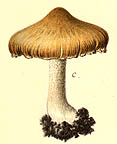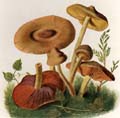 Key to Gilled Mushrooms Key
Key to Gilled Mushrooms KeyThis is a key to gilled mushrooms, that is, mushrooms having a definite cap with a fertile surface consisting of gills. The fruiting body usually also has a stem, although that may be lateral or absent (usually, then, the mushroom is growing from wood). You can use this key to identify mushrooms that you find.
 Agaricales Order
Agaricales OrderFruiting body containing fibers (usually in the stalk)
 Brown, Olive, Orange or Tan Spored Suborder
Brown, Olive, Orange or Tan Spored SuborderGills not free
Spore print tan, orange, deep ochre, yellowish olive, olive brown, rusty or cinnamon brown or deep brown
Ring usually either absent or not membranous
 Terrestrial Brown Spored Family
Terrestrial Brown Spored FamilyGrowing on the ground
 Inocybe Genus
Inocybe GenusCap with prominent radial fibers, often splitting radially
All parts of the mushroom often scaly, scurfy, or tufted with minute hairs (barely visible on the stem in this image)
Cap usually less than 2" across
Coarsely Fibrillose Inocybe Section

Diagnosis
- Cap with conspicuous pointed bundles or tufts of fibers; often with a torn appearance
-
Typically straw-colored or tan
Comments
Three of the most common species in this section, Inocybe fastigiata, Inocybe pyriodora, and Inocybe sororia, (and, I would add, Inocybe subochracea) are distinguished in the field mainly by smell (or, in the case of Inocybe subochracea, but the lack of it)
Narrow down your identification:
Inocybe caesariataCap up to 2" across; yellowish, darker at the disk; densely and minutely scurfy
Odor absent or faint
 Inocybe fastigiata
Inocybe fastigiataCap up to 3" across; straw-colored; conical at first, becoming umbonate
Odor spermatic
Inocybe lacera Cap up to 1 5/8" across; dark brown; sometimes slightly umbonate
Odor absent or very slight
Under aspen or conifers
 Inocybe pyriodora
Inocybe pyriodoraCap up to 2 3/4" across; straw-colored; conical at first, becoming umbonate
Odor strong, fragrant or spicy at first, becoming unpleasant in age; sometimes compared to overripe pears
 Inocybe sororia
Inocybe sororiaCap up to 3" across; straw-colored; conical at first, becoming umbonate
Odor of green corn or corn husks, strong
 Inocybe subochracea
Inocybe subochraceaCap up to 2" across; straw-colored; conical at first, becoming umbonate
Odor "strong", according to R. Phillips (1991) ; or "not distinctive", according to A. E. Bessette, D. W. Fischer & A. R. Bessette (1997)






 Key to Gilled Mushrooms Key
Key to Gilled Mushrooms Key Agaricales Order
Agaricales Order Brown, Olive, Orange or Tan Spored Suborder
Brown, Olive, Orange or Tan Spored Suborder Terrestrial Brown Spored Family
Terrestrial Brown Spored Family Inocybe Genus
Inocybe Genus
 Inocybe fastigiata
Inocybe fastigiata Inocybe pyriodora
Inocybe pyriodora Inocybe sororia
Inocybe sororia Inocybe subochracea
Inocybe subochracea




